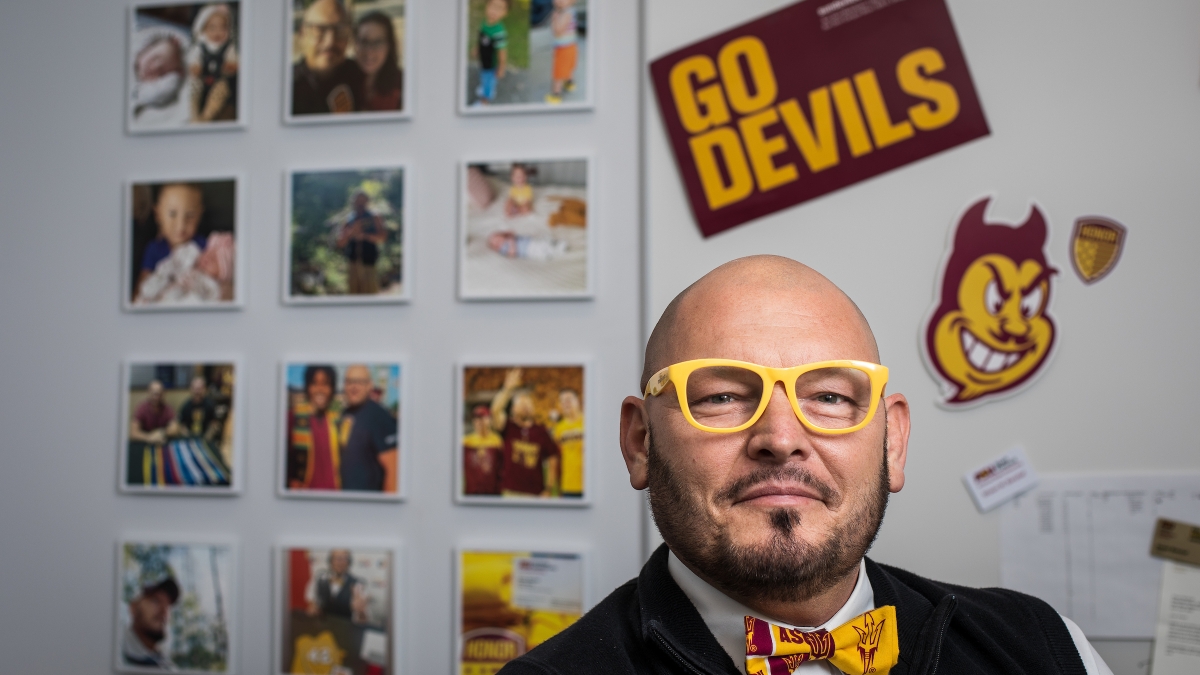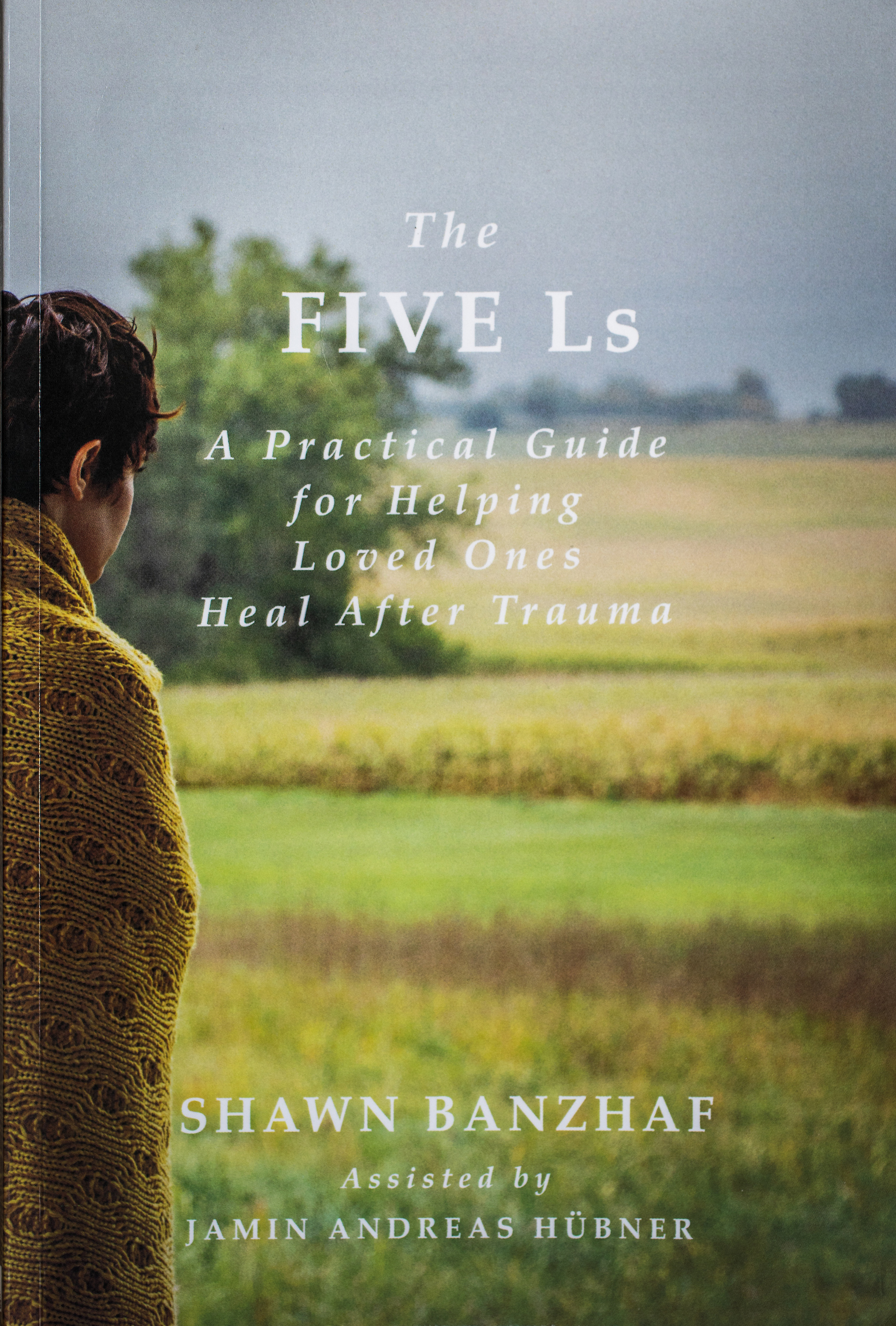Shawn Banzhaf has seen things that most people never do — death and carnage on the battlefield.
As a result of his tour in Iraq, Banzhaf has post-traumatic stress (PTS). Over the years he has learned to manage and live with it. Now he’s passing along his knowledge to other fellow veterans in his book “The Five Ls: A Practical Guide for Helping Loved Ones Heal After Trauma.”
“The biggest danger for soldiers isn’t bombs or bullets on a foreign battlefield; it’s something within our own borders — lurking in our very homes,” said Banzhaf, assistant director of student success with Arizona State University’s Pat Tillman Veterans Center. “There are very few things as traumatizing as war. And there are very few challenges like engaging in combat for several years and then going back home and trying to live a ‘normal life.’”
In time for National PTSD Awareness Day on June 27, ASU News spoke with Banzhaf and others around ASU who do research into trauma or provide support for those experiencing PTS and PTSD.
Banzhaf’s book is written with fellow veterans and their loved ones in mind but others with psychological trauma can benefit as well. He said the impetus of the book, which took a year to write, were the disheartening statistics on veteran suicides.
According to the Department of Veteran Affairs, roughly 20 U.S. veterans kill themselves a day. And since 2006, there has been an 86% increase in suicide rate among 18- to 34-year-old male veterans. Furthermore, approximately 40,000 U.S. veterans are homeless on any given day.
It was a younger veteran student who was struggling with PTSD that made Banzhaf finally sit down and write his 127-page book. The student had overheard someone talking about trauma, and words had been exchanged.
“When this student came to see me, he was angry, disordered and chaotic,” Banzhaf said. “He wasn’t comfortable in his seat and had this blank look on his face. Right away I knew he had PTSD before he admitted it to me. I’d been in that space.”
Indeed he had.
Triangle of death
Banzhaf was already a 16-year veteran with the Nebraska Army National Guard when his unit was mobilized to serve as part of Operation Iraqi Freedom in 2006. Banzhaf’s base was in an area near Ramadi, Fallujah, and Baghdad known as the “Triangle of Death.” His superiors put him in charge of protecting ammunition and convoys, hauling materials to other units and companies. That meant Banzhaf ran point and rode shotgun in the first armored service vehicle. His company ran approximately 1,600 combat missions in which they earned the Meritorious Unit Citation and sustained multiple injuries from improvised explosive devices (IEDs). His platoon lost one soldier to a roadside bomb on the outskirts of Baghdad, and several others were injured during Banzhaf’s yearlong deployment.
Since Banzhaf returned home in 2007 as a sergeant first class, his unit lost three people to suicide. The last death, that of a friend, really got to him.
“Like countless other friends and family members who have lost loved ones like this, I’m left wondering, 'What on Earth could have been done to prevent it?'” Banzhaf said.
The Five L’s
A book would not emerge until several years later. Despite a Bronze Star and a Combat Action Badge, Banzhaf had his own demons to contend with.
“I remember being home six days after I was in combat, and the thought hit me that it was only a week before that somebody was trying to kill me with an IED,” Banzhaf said. “I was standing in the living room on my carpeted floor with no real time to decompress what I saw. One of the hardest things to come home to was mediocrity because (on the front lines) we lived in a space of pure adrenaline and the body just doesn’t compute this.”
Banzhaf noticed he had more triggers and stressors when he got back from Iraq. Nightmares were vivid recreations of the trauma he had experienced in combat. Wherever he went, he sat with his back to the wall. Fireworks and sudden explosions made him jumpy. He drove everywhere at half the speed limit, looking for possible IEDs on the road. He said even his bed was too big, and he slept on the couch to be closer to an exit door.
“Your mind keeps score of all the trauma and the things that happened to you in combat, and you’re disordered,” Banzhaf said. “There was pre-war Shawn, and there’s post-war Shawn. Now I had to figure out how do I become the best version of post-war Shawn?”
Much of the credit, Banzhaf said, goes to his wife, Jodi, an academic adviser for ASU’s Mary Lou Fulton Teachers College. He said she demonstrated active and conscious selflessness, which he calls in his book the Five L’s: Love, Listen, Learn, Lessen and Lead.
“We love because healthy and happier people around us means we can be healthier and happier. No one truly lives in isolation,” Banzhaf said. “We live in communities and depend on each other, even when we try not to. That’s how we’re made, and that’s how human civilization survives.”
Research and support around ASU
Other departments and academic units at ASU are also involved with PTSD research and support. They include the Department of Psychology, T. Denny Sanford School of Social and Family Dynamics, Global Sport Institute and ASU Counseling Services.
The subject is often brought up in M. Jennifer Brougham’s class Working With Military Families, in the Sanford School.
“We often look at PTSD from the family or caretaker’s point of view,” said Brougham, who has been teaching the class since 2017 and is a former Army wife. “It impacts the family with often erratic behavior. Sometimes people with PTSD are very secretive about their condition and don’t necessarily want to admit when there’s a problem. So we try and bring in experts to show them to recognize the signs and coping.”
Aaron Krasnow, associate vice president and director of ASU’s Health and Counseling Services, said his office is dedicated to helping student veterans recognize the signs if they are experiencing PTSD.
“Not everyone who experiences trauma immediately has PTSD. It doesn’t necessarily affect all parts of their life all the time, and some people never experience post-traumatic stress,” Krasnow said. “It can be varied. It can creep up on people. Sometimes it can feel like it comes out of nowhere and catches them off guard.”
Krasnow said his office has worked with student veterans who have experienced trauma or PTSD, and can teach skills in recognizing the symptoms and effectively managing it when they are triggered or stressed.
“In addition to counseling, the first thing we try and do is help veterans to accept that this is not their fault and ways to find allies in the community to validate that they’re not alone,” Krasnow said. “Sometimes we might choose to refer them to a specialist if they need it, but all of our focus is on making sure they get the most they can out of their academic and personal lives.”
Karen Gallagher, senior researcher for ASU’s Global Sport Institute, works with military members with traumatic brain injury and focuses on their overall wellness. PTSD is one of the many byproducts of a trauma event or events, she said. Many times PTSD is delayed until soldiers go back to civilian life.
“What we have found in our research is that the bond you form with others in the military is intense and can provide a buffer to trauma,” said Gallagher, who is a Gulf War veteran. “When veterans leave that protective environment, they’re removed from those bonds and unified sense of purpose. So now they’re in a civilian world that might not totally understand them and they might not be able to relate to, and they begin to experience trauma.”
Students, teachers and the ASU community would do well to try to understand student veterans by creating a welcoming atmosphere and not asking intrusive questions about very private matters, said Rebecca K. Blais, an associate professor in the Department of Psychology.
“I think we do a disservice to military members when we say they’ll be ‘transitioning back to civilian life’ because we’re not honoring the sacrifices they’ve made as members of the military — those experiences stay with them forever,” said Blais, who has been researching PTSD in veterans for approximately 13 years. “It’s important to them to carry that identity of a veteran and soldier. When they arrive on a university or college campus, many people say, ‘Welcome. You are now a college student.’ In reality, they’re a college student and a veteran. Both of those identities are important to them. There is never a reason to shed either one of those identities.”
And although it’s nice that veterans are welcomed, Blais suggested not to pry for details of the past. Allow the veteran to share as they are ready and willing.
“The thing to understand is that every situation is going to be different. Some veterans are going to be proud of their service and others are not, and you’ll never know just by looking at them if they’re proud,” Blais said. “I would ask people to please be sensitive in their questions to veterans and to be empathetic in their interactions.”
Banzhaf said he is glad he works for a university that supports his work and the veteran community at large.
“I believe it’s important that ASU continues to be what our charter says we are,” Banzhaf said. “An inclusive university.”
Top photo: Shawn Banzhaf, a senior military advocate and assistant director of student success with ASU’s Pat Tillman Veterans Center, inside his home in south Phoenix. He recently penned "The Five L's: A Practical Guide for Helping Loved Ones Heal After Trauma." The 127-page book offers practical advice to fellow veterans who suffer from Post Traumatic Stress Disorder. Photo by Charlie Leight/ASU News
More Science and technology

Breakthrough copper alloy achieves unprecedented high-temperature performance
A team of researchers from Arizona State University, the U.S. Army Research Laboratory, Lehigh University and Louisiana State University has developed a groundbreaking high-temperature copper alloy…

4 ASU researchers named senior members of the National Academy of Inventors
The National Academy of Inventors recently named four Arizona State University researchers as senior members to the prestigious organization.Professor Qiang Chen and associate professors Matthew…

Transforming Arizona’s highways for a smoother drive
Imagine you’re driving down a smooth stretch of road. Your tires have firm traction. There are no potholes you need to swerve to avoid. Your suspension feels responsive. You’re relaxed and focused on…



